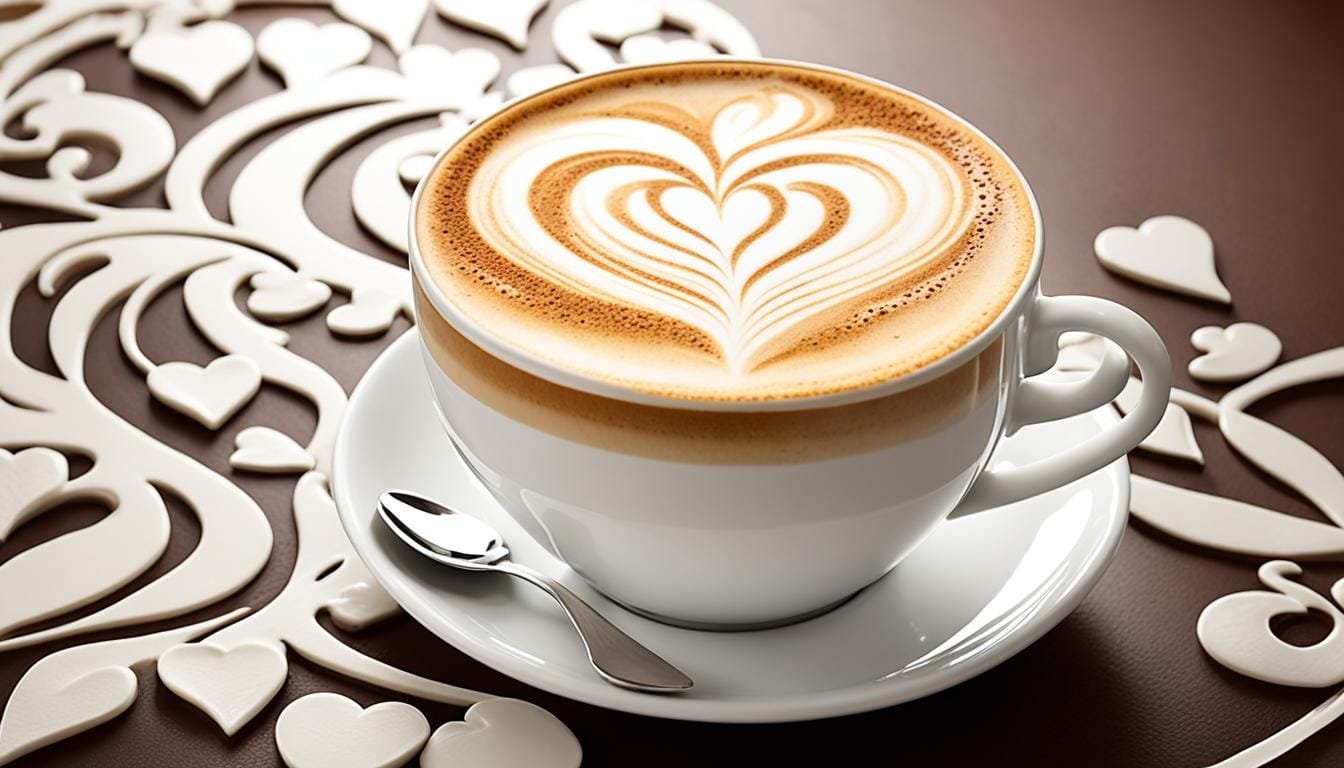Did you know that latte art has become a competitive sport, with baristas from around the world showcasing their skills in latte art competitions? The level of precision and creativity required to create intricate designs on the surface of a latte is truly astonishing. If you’re eager to join the ranks of master latte artists, this article is for you. We will explore the best ways to perfect advanced latte art, from mastering the basics to learning professional secrets that will take your latte art to the next level.
Key Takeaways:
- Mastering the basics of latte art is crucial before diving into advanced techniques.
- Understanding pouring techniques and achieving the perfect milk texture is key to creating beautiful designs.
- Exploring advanced techniques like pour speed, proximity to the cup, and placement of the pitcher spout can help you create intricate designs.
- Perfecting advanced latte art requires attention to detail, continuous practice, and troubleshooting common issues.
- Attending latte art classes and participating in competitions can further refine your skills and provide valuable feedback.
Mastering the Basics of Latte Art
Before you can dive into the world of advanced latte art techniques, it is essential to master the basics. Understanding the fundamental principles of latte art will provide a solid foundation for creating beautiful designs that will impress both your customers and fellow baristas.
Steaming Milk to Perfection
One of the key elements in creating latte art is achieving the perfect texture of steamed milk. Properly steamed milk should be velvety smooth with a creamy consistency that allows for easy pouring and manipulation. To steam milk successfully, follow these steps:
- Start with cold, fresh milk. Whole milk is preferred due to its higher fat content, which contributes to a richer and silkier texture.
- Purge the steam wand to remove any residual water or milk from previous use.
- Submerge the steam wand just below the surface of the milk, positioning it slightly off-center to create a whirlpool effect.
- Activate the steam wand by turning the knob until you hear a hissing sound and see small bubbles forming on the surface of the milk.
- Lower the steam wand as the milk expands, keeping it just below the surface to create a consistent vortex and distribute heat evenly.
- Monitor the temperature using a thermometer, removing the steam wand when the milk reaches around 150°F to 160°F (65°C to 71°C).
- Tap the milk pitcher on a hard surface to remove any large bubbles and swirl the milk to ensure even distribution of the foam.
Steaming milk to the correct texture is the first step towards achieving latte art perfection. Practice this process until you can consistently produce silky-smooth milk.
Pouring Techniques and Creating a Blank Canvas
Once you have mastered the art of steaming milk, it’s time to focus on pouring techniques and creating a blank canvas for your latte art. The way you pour the milk into the espresso plays a crucial role in the final design. Here are some tips to consider:
- Pour into the center of the espresso shot, allowing the milk to disperse evenly throughout the cup.
- Control the speed of your pour to create different effects. A slow, steady pour will result in a more defined design, while a faster pour will create a blend of milk and espresso.
- Focus on steaming the right amount of milk for your cup. Avoid overfilling or underfilling the cup, as it can compromise the balance of flavors and affect the overall appearance of your latte art.
Creating a blank canvas for pouring is equally important. This involves pouring steamed milk into the espresso without any initial design, allowing you to manipulate the milk and create intricate patterns. The canvas should be smooth and even, ready to be transformed into a work of art.
By mastering the basics of steaming milk and perfecting your pouring techniques, you will lay a strong foundation for creating stunning latte art. These essential skills, combined with the right milk texture and a blank canvas, will set the stage for your creative journey into the world of advanced latte art.
Exploring Advanced Latte Art Techniques
Now that you have mastered the basics of latte art, it’s time to delve into advanced techniques that will elevate your skills to the next level. These techniques involve precise pouring methods, speed, proximity to the cup, and the placement of the pitcher spout. By mastering these factors, you can create intricate latte art designs that will amaze your customers and fellow baristas.
To create advanced latte art, it’s crucial to understand the significance of pouring speed. The speed at which you pour the milk will determine the intricacy and level of detail in your designs. Experiment with different pouring speeds to find the optimal one for each design. Remember, slow pouring allows for greater control and precision, while faster pouring can create more dynamic and fluid patterns.
In addition to pouring speed, the proximity to the cup plays a crucial role in advanced latte art. The distance between the pitcher spout and the cup’s surface will determine the level of detail and definition in your designs. The closer the spout is to the cup, the finer and more intricate the lines will be. Experiment with different distances to achieve the desired effect.
The placement of the pitcher spout is another essential factor in creating advanced latte art. By carefully positioning the spout, you can control the flow of milk and achieve specific patterns and shapes. For example, placing the spout slightly off-center will allow you to create symmetrical designs, while placing it closer to the edge of the cup will result in more irregular and abstract shapes.
Examples of Advanced Latte Art Designs:
1. Indian Chief:
Pouring method: Free pour
Pouring speed: Slow
Proximity to the cup: Close
Placement of the pitcher spout: Centered
2. Wave Tulip:
Pouring method: Etching
Pouring speed: Medium
Proximity to the cup: Medium
Placement of the pitcher spout: Off-center
3. Inverted Tulip:
Pouring method: Free pour
Pouring speed: Fast
Proximity to the cup: Close
Placement of the pitcher spout: Off-center
4. Swan:
Pouring method: Etching
Pouring speed: Slow
Proximity to the cup: Close
Placement of the pitcher spout: Centered
5. Phoenix:
Pouring method: Free pour
Pouring speed: Medium
Proximity to the cup: Medium
Placement of the pitcher spout: Off-center
6. Scorpion:
Pouring method: Etching
Pouring speed: Fast
Proximity to the cup: Close
Placement of the pitcher spout: Off-center

By mastering advanced latte art techniques, you can create stunning and visually captivating designs. Remember to practice and experiment with different pouring methods, speeds, proximity to the cup, and placement of the pitcher spout to achieve the desired effects. With dedication and creativity, you can amaze your customers and take your latte art to new heights.
Tips and Tricks for Perfecting Advanced Latte Art
Perfecting advanced latte art requires attention to detail and continuous practice. To help you on your journey, here are some valuable tips and tricks:
- Master Troubleshooting: Troubleshooting common issues is essential for consistently excellent latte art. If you encounter uneven texture or inconsistent pouring, analyze your process and make adjustments accordingly.
- Pouring Tips: Pay attention to your pouring techniques to create visually stunning designs. Experiment with stackingshapes and wiggling techniques to add depth and texture to your latte art creations.
- Explore Multi-layered Designs: Take your latte art to the next level by pouring multi-layered designs. By pouring different layers of milk at various stages, you can create intricate patterns and visually appealing compositions.
| Troubleshooting | Pouring Tips | Multi-layered Designs |
|---|---|---|
| Troubleshoot common issues | Experiment with stackingshapes and wiggling techniques | Create intricate patterns with multiple layers |
| Uneven texture or inconsistent pouring? | Add depth and texture to your designs | Experiment with pouring different layers |
 |
By implementing these latte art tips and tricks, you can refine your skills and create latte art that is truly impressive. Remember to continue practicing and experimenting to further elevate your craft. With dedication and persistence, you will become a master of advanced latte art.
Conclusion
Elevating your barista skills through perfecting advanced latte art is a rewarding pursuit. By mastering the basics, exploring advanced techniques, and utilizing valuable tips and tricks, you can create stunning latte art designs that are sure to impress.
Remember to continuously practice and seek opportunities to refine your skills, such as attending latte art classes or participating in competitions. These experiences will not only enhance your abilities but also connect you with like-minded individuals who share your passion for latte art.
With dedication and a true love for the craft, you can become a master of advanced latte art. Delighting both yourself and others with your artistic creations, you will feel a sense of fulfillment and accomplishment in producing unique and visually captivating designs.
FAQ
What are the best ways to perfect advanced latte art?
Perfecting advanced latte art requires a combination of techniques, practice, and attention to detail. Mastering the basics of steaming milk, pouring techniques, and creating a blank canvas for pouring is crucial. Once you have a solid foundation, you can explore advanced techniques like controlling pour speed, proximity to the cup, and placement of the pitcher spout to create intricate designs.
How do I master the basics of latte art?
Mastering the basics of latte art involves understanding how to steam milk to achieve the perfect texture and how to pour into the center of the espresso. Prepping your milk before pulling a shot, steaming milk to the correct texture, and creating a blank canvas for pouring are all important steps in mastering latte art.
What are some advanced latte art techniques I can explore?
Advanced latte art techniques include controlling pour speed, proximity to the cup, and placement of the pitcher spout. By manipulating these factors, you can create intricate designs such as the Indian Chief, Wave Tulip, Inverted Tulip, Swan, Phoenix, and Scorpion.
What are some tips and tricks for perfecting advanced latte art?
Some valuable tips and tricks for perfecting advanced latte art include troubleshooting common issues, such as uneven texture or inconsistent pouring, mastering the art of stacking shapes, wiggling techniques, and pouring multi-layered designs. These techniques will help you create complex and visually stunning latte art.
How can I elevate my latte art skills?
Elevating your latte art skills involves continuous practice and seeking opportunities to refine your skills. Consider attending latte art classes or participating in competitions to further enhance your abilities. With dedication and a passion for the craft, you can become a master of advanced latte art and create impressive designs.




